Facial Expression Recognition App Using Deep Learning
Students: Samuel Nwuha (CS), Stekunda Henry (CS), Ben Riesett (CS), Ben Davenport (CS), Eric Charley (CS), Hoang Dao (CS)
Advisors: Dr. Lin-Ching Chang, Dr. Dominick Rizk
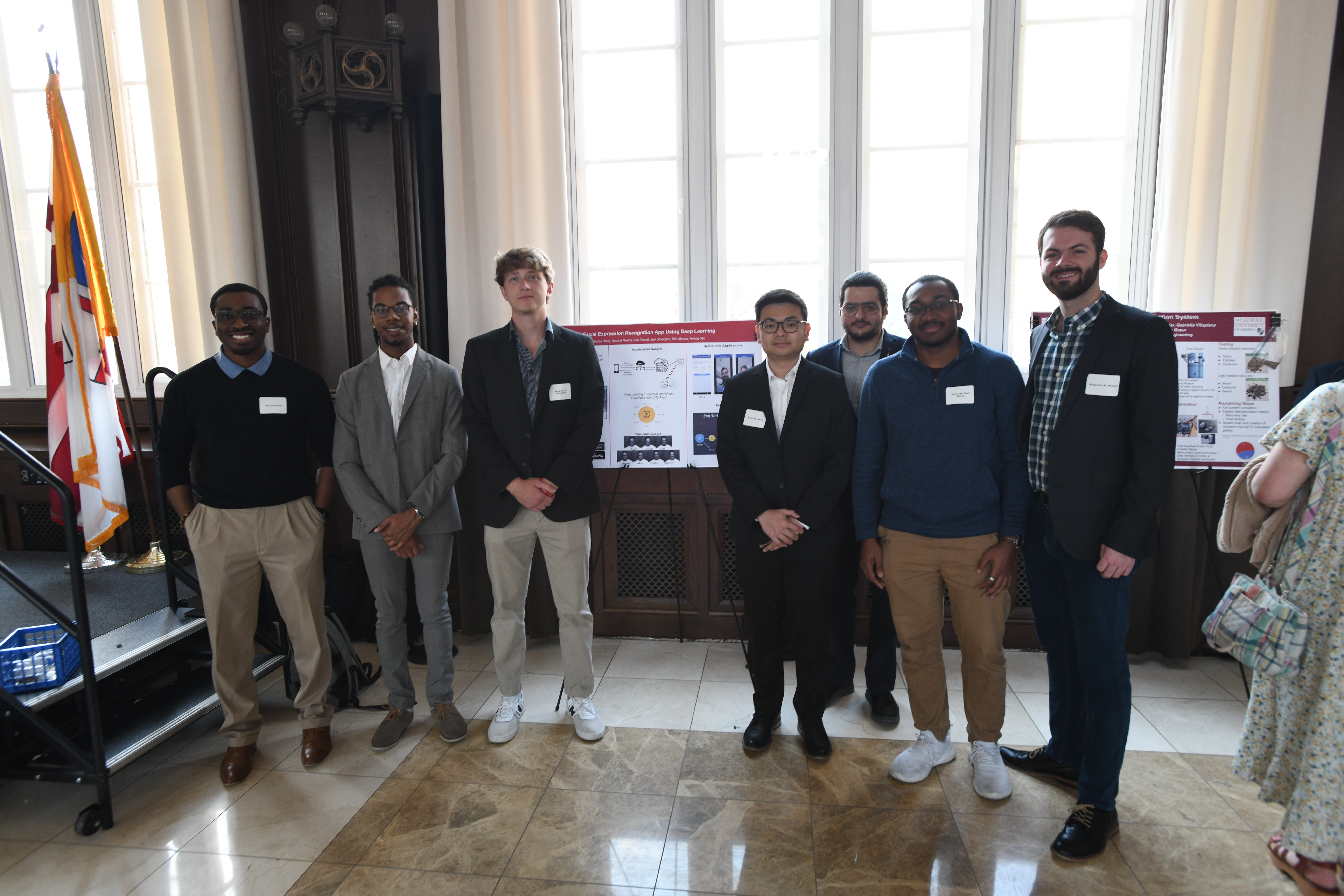 Facial Expression Recognition is a rapidly growing and extremely beneficial technology. There are many applications for expression recognition, including security, healthcare, disability assistance, and mood classification. The problem that facial expression recognition solves is the inability of a computer system to recognize feelings and emotions. Facial expression recognition lets a computer identify and record emotions via deep learning. We aim to use this software to create a mobile application capable of accurately recognizing facial expressions in photos or videos. Facial Recognition has increased in popularity over the past few years. This is due to increased home and mobile devices being equipped with IR depth sensors capable of performing 3D scans of faces to determine shape, structure, and other fine details. Anyone can use this technology, whether it is to unlock a phone, identify a disability, or identify different expressions. This benefits people who prioritize easy access to secure systems via biometrics, anybody who would like to study different emotions, and many more. In our design, we aim to develop a multi-platform mobile application using Dart and the Flutter Framework. This application will provide an intuitive UI to take a photo, which will then be processed by a custom Python script that sends the image through a deep neural network that identifies the emotion. A large data set of different expressions will train the neural network. The script will return the expression, which will then be displayed on the screen with the picture. Our prototype will allow users a convenient way to identify an expression through an image. State-of-the-art facial expression recognition has been used in many different applications previously. Still, we are expanding on it to provide a convenient and fun service to those interested in creating a seamless integration of emotion and technology.
Facial Expression Recognition is a rapidly growing and extremely beneficial technology. There are many applications for expression recognition, including security, healthcare, disability assistance, and mood classification. The problem that facial expression recognition solves is the inability of a computer system to recognize feelings and emotions. Facial expression recognition lets a computer identify and record emotions via deep learning. We aim to use this software to create a mobile application capable of accurately recognizing facial expressions in photos or videos. Facial Recognition has increased in popularity over the past few years. This is due to increased home and mobile devices being equipped with IR depth sensors capable of performing 3D scans of faces to determine shape, structure, and other fine details. Anyone can use this technology, whether it is to unlock a phone, identify a disability, or identify different expressions. This benefits people who prioritize easy access to secure systems via biometrics, anybody who would like to study different emotions, and many more. In our design, we aim to develop a multi-platform mobile application using Dart and the Flutter Framework. This application will provide an intuitive UI to take a photo, which will then be processed by a custom Python script that sends the image through a deep neural network that identifies the emotion. A large data set of different expressions will train the neural network. The script will return the expression, which will then be displayed on the screen with the picture. Our prototype will allow users a convenient way to identify an expression through an image. State-of-the-art facial expression recognition has been used in many different applications previously. Still, we are expanding on it to provide a convenient and fun service to those interested in creating a seamless integration of emotion and technology.
Continuous Glucose Monitor
Students: Mohammad Alghamdi (ME), Yassir Alqahtani (EE), Anna Keyes (CS), Pauline Oteyza (BE), Christian Urcia (BE)
Advisors: Dr. Christopher Raub, Dr. Otto Wilson
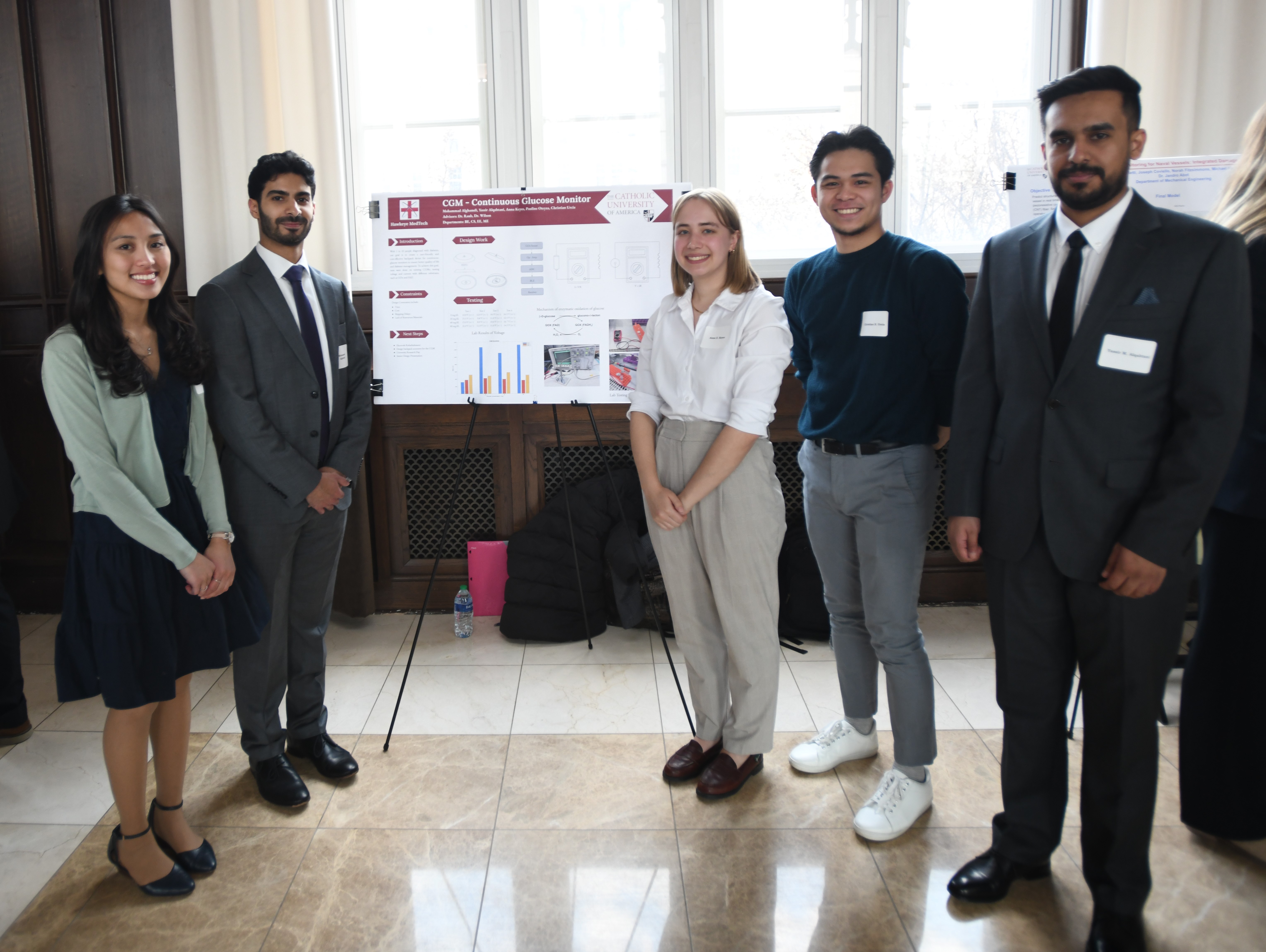 Known as the "invisible epidemic," diabetes affects millions around the globe. Diabetic patients suffer more than just the great physical toll of this disease on their bodies—they also suffer the financial burden of expensive care and single-use medical equipment. The main objective of this project is to find a way to adequately monitor blood sugar levels to decrease rates of morbidity and mortality among diabetics as well as alleviate the burden of costly care on diabetics. This goal is accomplished using methods of continuous glucose monitoring. A continuous glucose monitor, or CGM, is a minimally invasive medical device used in diabetes management. The CGM measures glucose levels in either the back of the arm or the abdomen, providing real-time health data to the user. Three components comprise the device: a sensor, a transmitter, and a receiver. The sensor detects glucose in the body using a chemical enzyme called glucose oxidase. It then sends a signal from the transmitter to the receiver, which displays the glucose level data gathered within the body. Commercial CGMs, though useful, are expensive and must be replaced frequently. Most commercial monitor sensors have a life expectancy of 10-14 days, after which point the device ceases functioning. For this project, our team developed a solution to refurbish the glucose oxidase sensor paired with a “backpack” device that attaches to a commercial CGM to lengthen the unit’s life. The result is a design that extends the use of the device, reduces waste, and makes for more affordable care overall.
Known as the "invisible epidemic," diabetes affects millions around the globe. Diabetic patients suffer more than just the great physical toll of this disease on their bodies—they also suffer the financial burden of expensive care and single-use medical equipment. The main objective of this project is to find a way to adequately monitor blood sugar levels to decrease rates of morbidity and mortality among diabetics as well as alleviate the burden of costly care on diabetics. This goal is accomplished using methods of continuous glucose monitoring. A continuous glucose monitor, or CGM, is a minimally invasive medical device used in diabetes management. The CGM measures glucose levels in either the back of the arm or the abdomen, providing real-time health data to the user. Three components comprise the device: a sensor, a transmitter, and a receiver. The sensor detects glucose in the body using a chemical enzyme called glucose oxidase. It then sends a signal from the transmitter to the receiver, which displays the glucose level data gathered within the body. Commercial CGMs, though useful, are expensive and must be replaced frequently. Most commercial monitor sensors have a life expectancy of 10-14 days, after which point the device ceases functioning. For this project, our team developed a solution to refurbish the glucose oxidase sensor paired with a “backpack” device that attaches to a commercial CGM to lengthen the unit’s life. The result is a design that extends the use of the device, reduces waste, and makes for more affordable care overall.
Sponsor: Hawkeye Medtech
Golf Adaptation Device
Students: Margaret Brautigan (BE), Adam Gleaton (BE), Oluwatosin Johnson (BE), Julia Shelepov (BE), Ryan Walczak (BE)
Advisor: Dr. Gregory Behrmann
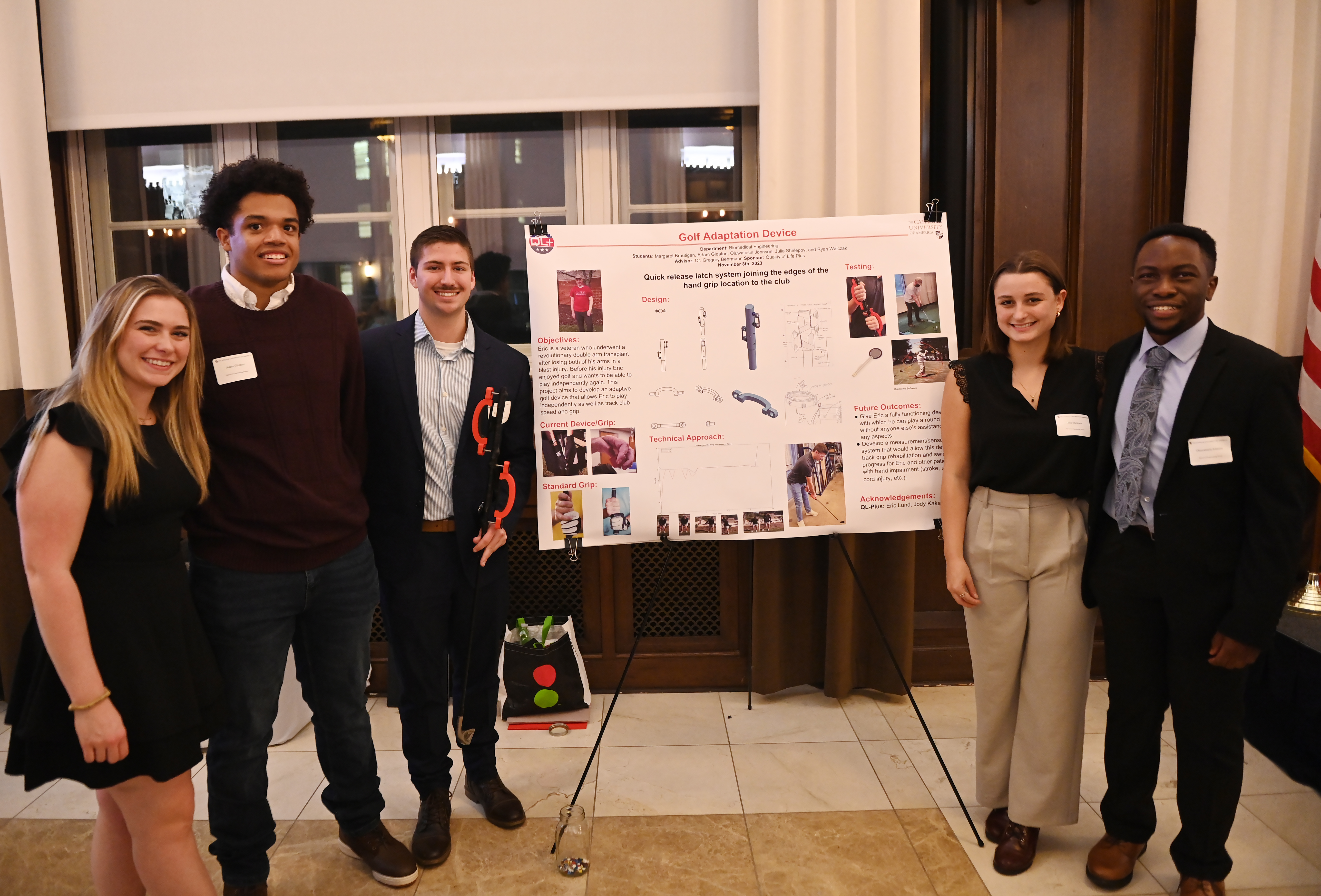 The Golf Adaptation Device aims to find a way for a retired Army Infantryman, who lost both arms from a blast injury in 2012 and received a bilateral hand transplant surgery, to play a round of golf with maximum independence. At this point, the subject does not have complete function of their forearms, wrists, and hands, and requires an assistive device to play golf.
The Golf Adaptation Device aims to find a way for a retired Army Infantryman, who lost both arms from a blast injury in 2012 and received a bilateral hand transplant surgery, to play a round of golf with maximum independence. At this point, the subject does not have complete function of their forearms, wrists, and hands, and requires an assistive device to play golf.
The device criteria are: the patient should be able to put the device on their body with ease, attach to the desired club, remain secure during repeated swings, easily detach, and quickly switch between clubs. Additionally, the device aims to help subjects track rehabilitation progress by monitoring club speed and grip strength during swings. This device may be helpful to other individuals rehabilitating hand and arm function through sports physical therapy, such as patients recovering from a stroke.
By modifying weight-lifting hooks and incorporating quick-release trunk latch buttons and pins, the device allows the patient to lock and unlock onto different golf clubs. The final design aims to provide a device that remains stable over multiple swings, allowing the subject and other patients to successfully and independently play golf while undergoing upper limb function rehabilitation.
Sponsor: Quality of Life Plus
Hyperspectral Imaging Camera
Students: Dat Dao (EE), Salvatore Soriano Jr. (EE), Adam Pettyjohn (ME), Surafel Tadesse (CS)
Advisor: Dr. Georges Nehmetallah
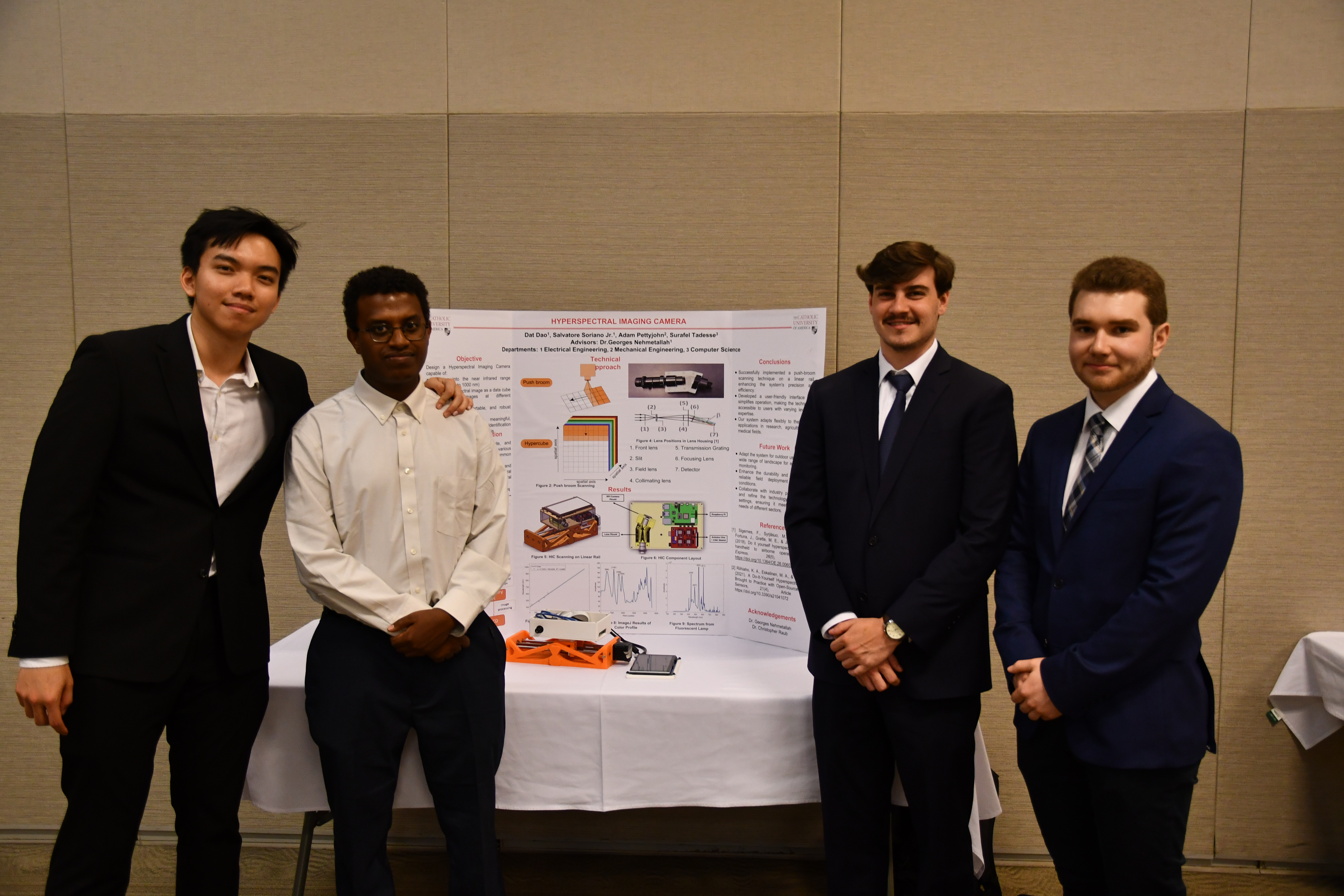 Hyperspectral imaging (HSI) is a technology that captures and processes information from across the electromagnetic spectrum, extending beyond the visible range. Traditional HSI devices are often large and heavy, making them challenging to use in field applications and situations where portability may be essential. Users unfamiliar with these systems may find it challenging to operate traditional HSI devices due to their operational complexity, often requiring specialized training for effective use. This project aims to address the issue of limited accessibility to hyperspectral imaging technology due to high costs and the impracticality of existing systems. This project will focus on creating an affordable, easy-to-carry, durable, and portable hyperspectral imaging system; expanding access to a broader audience beyond academia.
Hyperspectral imaging (HSI) is a technology that captures and processes information from across the electromagnetic spectrum, extending beyond the visible range. Traditional HSI devices are often large and heavy, making them challenging to use in field applications and situations where portability may be essential. Users unfamiliar with these systems may find it challenging to operate traditional HSI devices due to their operational complexity, often requiring specialized training for effective use. This project aims to address the issue of limited accessibility to hyperspectral imaging technology due to high costs and the impracticality of existing systems. This project will focus on creating an affordable, easy-to-carry, durable, and portable hyperspectral imaging system; expanding access to a broader audience beyond academia.
Specifically, the proposed HSI system will be capable of capturing wavelengths from the 400-1000 nm range, enabling consumers to capture a scene in a series of scanned frames. The HSI system will be developed with a lightweight 3D printed case containing a Raspberry Pi for the control system, a transmission grating lens setup, and a LCD touchscreen to operate the device. It will also utilize a linear rail scanning technique, ensuring ease of use and portability. The methodology used in our design is based on scanning the scene line by line, known as push-broom scanning, restricting the light passing through the front lens using a narrow slit. A diffraction grating diffracts the collimated light into different wavelengths, and a lens focuses the light onto the sensor of the camera. Stacking the frames together forms the final hyperspectral image, called a data cube, that consists of two spatial and one spectral dimension. The data collected from the HSI system will be displayed on the LCD display, to allow users to quickly view the data.
Posturography for Non-Ambulatory Individuals
Students: Elizabeth Caufield (BE), Maria Huerta (BE), Alexander Pietrangelo (EE), Zachary Antonucci (EE)
Advisor: Dr. Christopher Raub
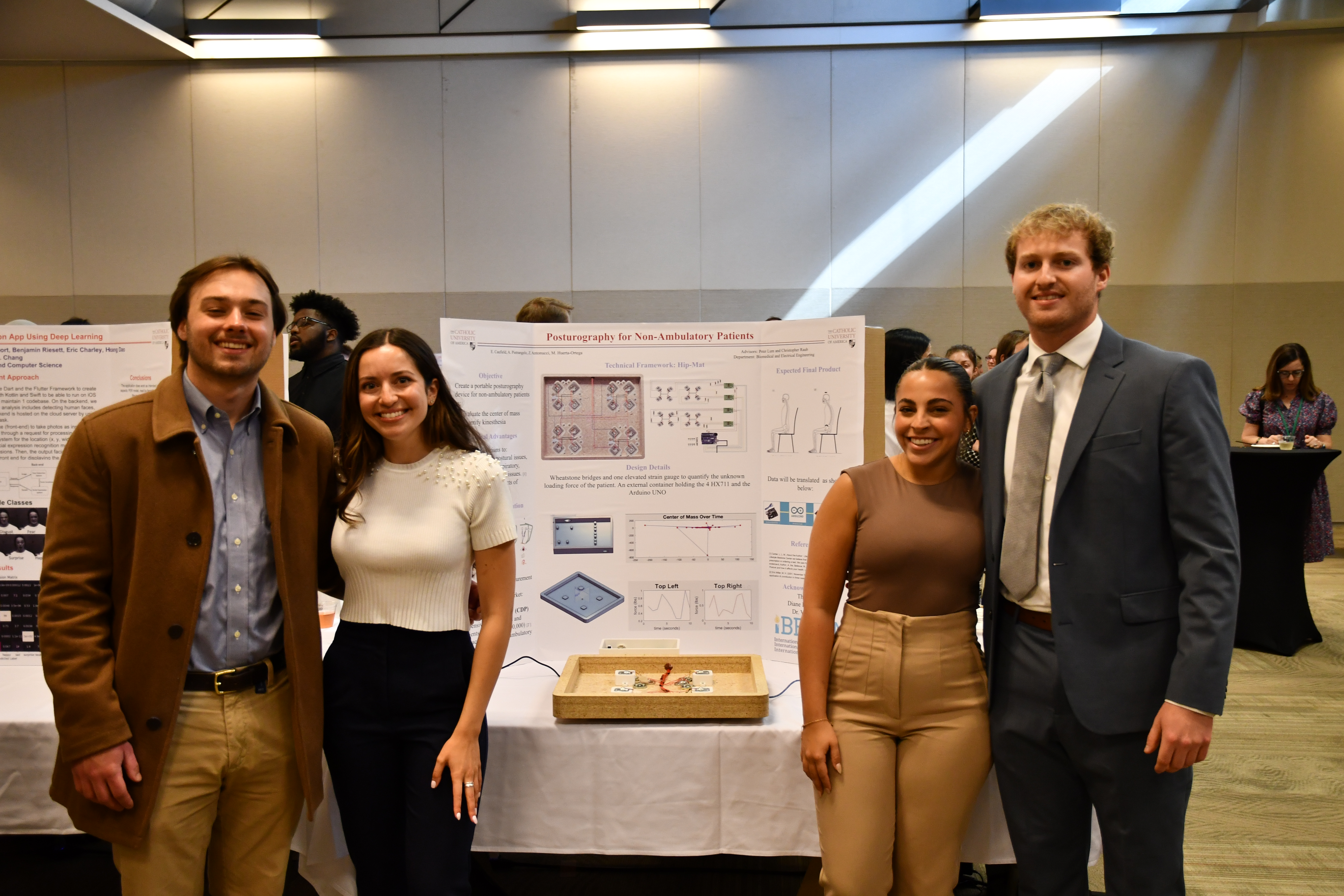 The posturography device for non-ambulatory patients gives an overall sense of a patient’s postural health that provides clinicians with a lower-cost alternative for a new rehabilitation diagnostics tool. Its main purpose is a way for non-ambulatory people, focusing on cerebral palsy, spinal cord injury, and traumatic brain injury patients, to be able to get their posture assessed. Our aim is to do this by creating a solution that does not require the patient to stand and provides data tracking for improvement of posture and mobility. The current prototype is utilized by placing the patient in a fixed seated force plate connected to force sensors, which can detect small movements in the patient's center of mass. The external device used by the patient has been made to be more robust and ergonomic than previous designs, and the fixture itself in the final version will be made from lightweight metal and acrylic. The final device will also have two motion sensors attached to the back of the neck and the spine to quantify the changes in spinal length and motion. The final product will also be accompanied by an app that can allow the physical therapist or clinician to see all the data from the simplicity of an electronic device. The posturography device has the capability to bridge a gap in the clinical market for inclusive diagnostic tools and to improve the quality of medical diagnosis for clinicians and patients.
The posturography device for non-ambulatory patients gives an overall sense of a patient’s postural health that provides clinicians with a lower-cost alternative for a new rehabilitation diagnostics tool. Its main purpose is a way for non-ambulatory people, focusing on cerebral palsy, spinal cord injury, and traumatic brain injury patients, to be able to get their posture assessed. Our aim is to do this by creating a solution that does not require the patient to stand and provides data tracking for improvement of posture and mobility. The current prototype is utilized by placing the patient in a fixed seated force plate connected to force sensors, which can detect small movements in the patient's center of mass. The external device used by the patient has been made to be more robust and ergonomic than previous designs, and the fixture itself in the final version will be made from lightweight metal and acrylic. The final device will also have two motion sensors attached to the back of the neck and the spine to quantify the changes in spinal length and motion. The final product will also be accompanied by an app that can allow the physical therapist or clinician to see all the data from the simplicity of an electronic device. The posturography device has the capability to bridge a gap in the clinical market for inclusive diagnostic tools and to improve the quality of medical diagnosis for clinicians and patients.
Sponsor: International Institute for the Brain
Unmanned Aerial Vehicle Supply Mission
Students: Chizua Agupusi (ME), Lauren Cerda (ME), Nicholas DeLucia (ME), Joseph Gabris (ME), Olivia Rees (ME)
Advisor: Dr. Diego Turo
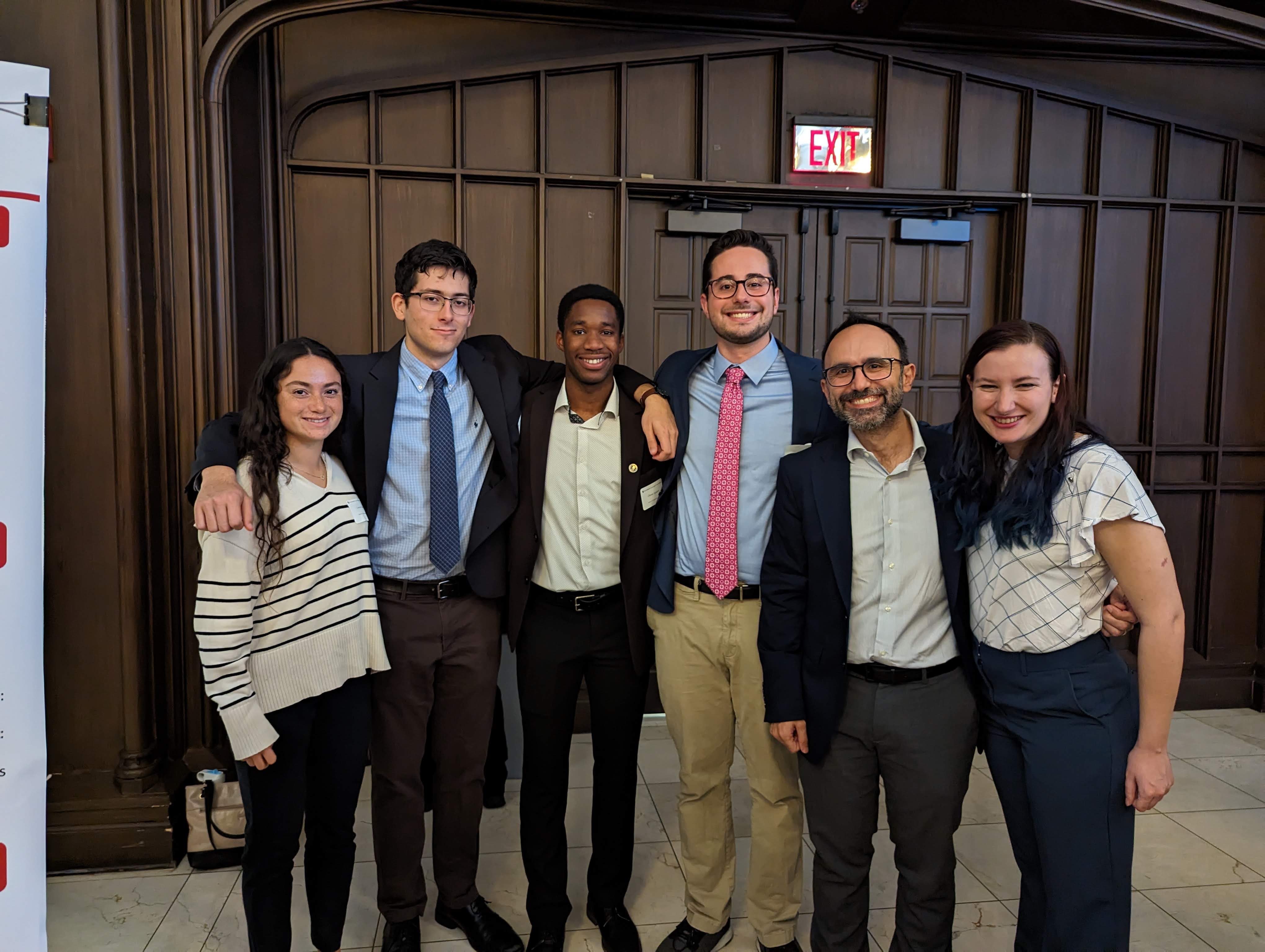 This work presents a method of delivering medical supplies via aircraft. Currently, unmanned aerial vehicles (UAV) are used by first responders, military medics, and hospitals while keeping them away from danger and facilitating quick delivery of lifesaving supplies. The expedited delivery of emergency goods is beneficial to those restricted from supply routes due to natural disasters or emergencies. A low-cost and low-maintenance solution to reliably reach remote areas that can deliver medical supplies to those in need is designed and presented. Available commercial solutions are able to deliver approximately four bags of blood and operate strictly along a fixed path. The proposed design aims to increase payload capacity while decreasing cost and eliminating the fixed-path constraint. The design makes use of aerodynamic calculations, numerical simulations, and experimental testing to inform design parameters. The plane is built using lightweight basswood, birch plywood, and high-density foam to maximize payload capacity and is covered in Monokote film to minimize aerodynamic drag. The proposed design is intended to maximize inflight stability and energy efficiency to prevent damaging the payload and allow for consecutive flights.
This work presents a method of delivering medical supplies via aircraft. Currently, unmanned aerial vehicles (UAV) are used by first responders, military medics, and hospitals while keeping them away from danger and facilitating quick delivery of lifesaving supplies. The expedited delivery of emergency goods is beneficial to those restricted from supply routes due to natural disasters or emergencies. A low-cost and low-maintenance solution to reliably reach remote areas that can deliver medical supplies to those in need is designed and presented. Available commercial solutions are able to deliver approximately four bags of blood and operate strictly along a fixed path. The proposed design aims to increase payload capacity while decreasing cost and eliminating the fixed-path constraint. The design makes use of aerodynamic calculations, numerical simulations, and experimental testing to inform design parameters. The plane is built using lightweight basswood, birch plywood, and high-density foam to maximize payload capacity and is covered in Monokote film to minimize aerodynamic drag. The proposed design is intended to maximize inflight stability and energy efficiency to prevent damaging the payload and allow for consecutive flights.
The Catholic University of America Steel Bridge Competition
Students: Patrick Dunphy (CE), Aidan Long (CE), Alex Farrari (CE), Miles Shealy (CE)
Advisor: Dr. Jason Davison
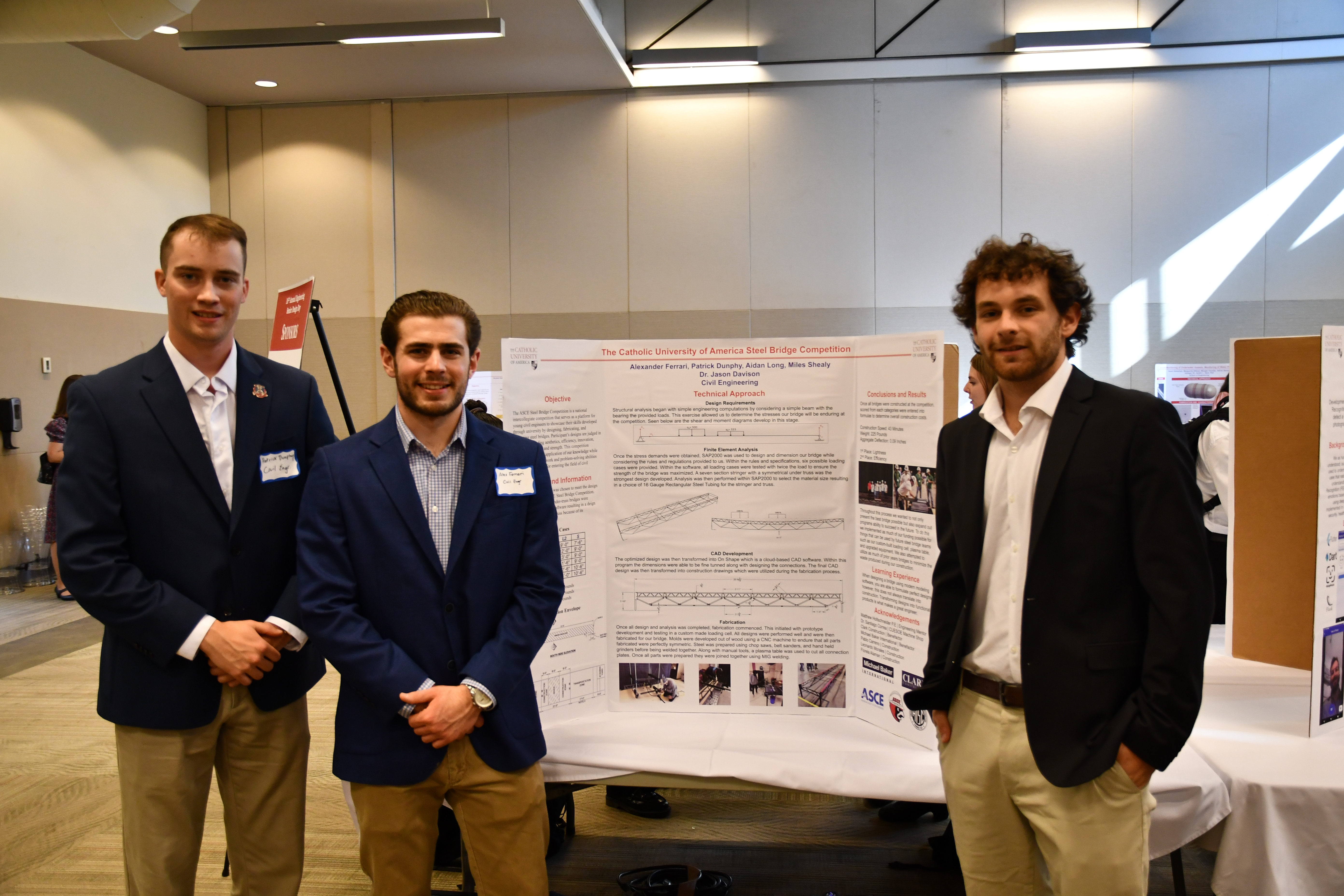 The ASCE Steel Bridge Competition is a national intercollegiate competition that serves as a platform for young civil engineers to showcase their skills developed through university by designing, fabricating, and presenting a steel bridge. Per the rules and regulations provided by the ASCE and AISC, the scope of work calls for a pedestrian bridge at a 1:10 scale model for Lincoln Park in Louisiana. Participant’s designs are judged in categories including aesthetics, efficiency, lightness, construction speed, and strength. Using online modeling software, a 21-foot steel bridge was designed and constructed using means of welding and custom bolted connections. Finite analysis and real-world testing showed minimal deflection when the load was applied. This competition promotes real-world application of our knowledge while also cultivating teamwork and problem-solving abilities which are crucial skills for entering the field of civil engineering.
The ASCE Steel Bridge Competition is a national intercollegiate competition that serves as a platform for young civil engineers to showcase their skills developed through university by designing, fabricating, and presenting a steel bridge. Per the rules and regulations provided by the ASCE and AISC, the scope of work calls for a pedestrian bridge at a 1:10 scale model for Lincoln Park in Louisiana. Participant’s designs are judged in categories including aesthetics, efficiency, lightness, construction speed, and strength. Using online modeling software, a 21-foot steel bridge was designed and constructed using means of welding and custom bolted connections. Finite analysis and real-world testing showed minimal deflection when the load was applied. This competition promotes real-world application of our knowledge while also cultivating teamwork and problem-solving abilities which are crucial skills for entering the field of civil engineering.
Sponsors:
Clark Construction
Michael Baker International
